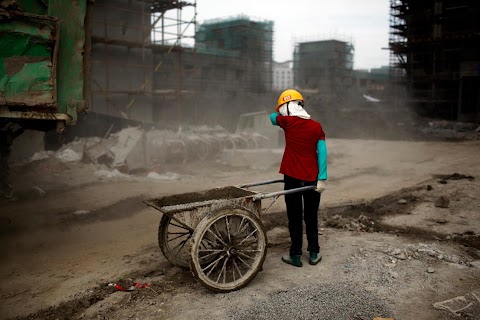
China’s parched earth
A woman takes a break as she harvests cotton near to the Shiyang river, which dried up in recent decades.
Hundreds of rivers have vanished in northwestern Gansu, one of the country's driest regions. Beijing blames climate change for wreaking havoc on scarce water resources, but critics say the country's headlong drive to build its industrial prowess and huge hydro projects are just as responsible.

Story
Chinese Government Sees Its Own Reflection In Water Crisis
On the eve of a global climate change conference in Stockholm, a U.N. climate body says shrinking glaciers in central Asia and the Himalayas would affect water resources in downstream river catchments, which include China.
"Some regions are already near the critical temperature threshold," the Intergovernmental Panel on Climate Change (IPCC) said in a draft summary report obtained by Reuters.
"In parts of Asia, increases in flood and drought will exacerbate rural poverty, due to negative impacts on rice crops and increases in food prices and costs of living."
Rising temperatures are likely to speed icecap melting in the Himalayas, which could bring first floods and then severe drought, with diminished seasonal melts unable to replenish China's rivers, including the mighty Yangtze.
This year, China published a national "water census" showing that as many as 28,000 rivers logged in a government database had vanished since the 1990s, leaving just under 23,000.
The census gave no reason for the disappearance, but China's weather bureau said several major rivers, including the Yellow River, a massive northern waterway linking nine provinces, had been dwindling since 1970 and the trend was likely to continue.
"We have witnessed major fluctuations in precipitation in different parts of China," said Ma Jun, a water expert and director of the Institute of Public and Environmental Affairs (IPE), which monitors China's rivers.
Rising temperatures are only part of China's problems, many of which have resulted from overpopulation, aggressive industrialisation and a huge reliance on elaborate engineering schemes to irrigate crops and harness scarce supplies.
"China's water shortages stem more from problematic urbanisation and water resource management, rather than the scapegoat of climate change," said Zhou Lei, a fellow at Nanjing University who studies how industry affects the environment.
"In my home town in Jiangxi, the water system consisted of underground springs, ponds, wetlands, brooks, streams, and seasonal rivulets, but all these have been totally ruined in the last 20 years due to a catastrophic urbanisation plan, a construction mania and transport megaprojects," he said.
WRINGING CHINA DRY
Hundreds of rivers have already vanished in northwestern Gansu, one of the country's driest regions.
In the town of Minqin, residents said the problem was not new, with the nearby Shiyang river disappearing not because of temperature rises, but because a vast upstream reservoir built two decades ago to irrigate a large farm cut off their supply.
China has long sought to wring as much water as it can from its parched earth, but is approaching the limits of what it can retrieve.
The reliance on megaprojects to solve shortages has created a vicious circle, channelling water to state-owned farms, giant industrial plants or hydropower stations, diverting natural flows and leaving surrounding areas more parched than before.
Some regions desperate for growth have been forced to choose between water and energy. Gansu plans to build several giant hydro plants in the upper reaches of the Yellow River, defying warnings that this could restrict downstream water supplies.
Elsewhere, green groups say scarce water resources are being diverted from agriculture to profitable coal-fired power plants, with China building thirsty "coal production bases" in dry areas such as Inner Mongolia, Ningxia and Shaanxi.
But even flood-prone southwestern provinces have suffered from droughts once regarded as unthinkable.
In Yunnan, dozens of rivers have been dammed to generate power, and complex canal systems built to improve irrigation.
Water diversion has made shortages more likely. Several rivers in the province have dried up over the last decade, and drought has been common. In April, hundreds of wells and streams dried up, creating a crisis for thousands of farmers.
"The negative impact of these big engineering projects could be quite serious and some of the problems could be transferred to other areas, especially in the west," said Ma.
"We spent our resources mainly on engineering and on technologies to drill deeper, build dams and work on water diversion projects, but we need to work on conservation."

































